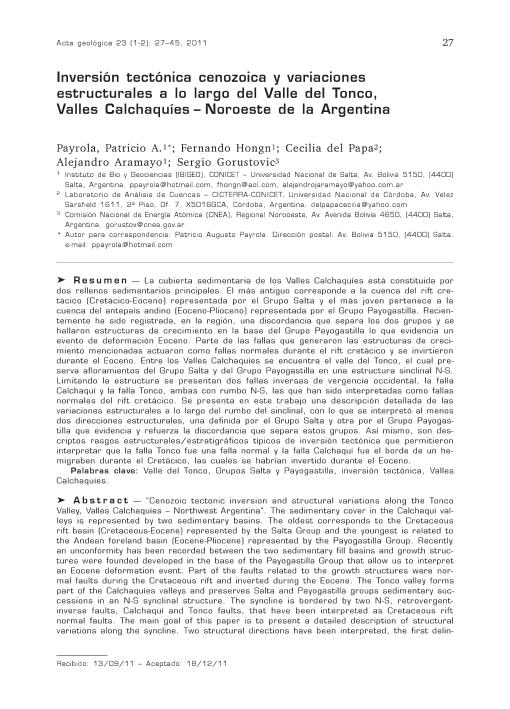Artículo
La cubierta sedimentaria de los Valles Calchaquíes está constituida por dos rellenos sedimentarios principales. El más antiguo corresponde a la cuenca del rift cretácico (Cretácico-Eoceno) representada por el Grupo Salta y el más joven pertenece a la cuenca del antepaís andino (Eoceno-Plioceno) representada por el Grupo Payogastilla. Recientemente ha sido registrada, en la región, una disco rdancia que separa los dos grupos y se hallaron estructuras de crecimiento en la base del Grupo Payogastilla lo que evidencia un evento de deformación Eoceno. Parte de las fallas que generaron las estructuras de creci- miento mencionadas actuaron como fallas normales durante el rift cretácico y se invirtieron durante el Eoceno. Entre los Valles Calchaquíes se encuentra el valle del Tonco, el cual preserva afloramientos del Grupo Salta y del Grupo Payogastilla en una estructura sinclinal N-S. Limitando la estructura se presentan dos fallas inversas de vergencia occidental, la falla Calchaquí y la falla Tonco, ambas con rumbo N-S, las que han sido interpretadas como fallas normales del rift cretácico. Se presenta en este trabajo una descripción detallada de las variaciones estructurales a lo largo del rumbo del sinclinal, con lo que se interpretó al menos dos direcciones estructurales, una definida por el Grupo Salta y otra por el Grupo Payogas- tilla que evidencia y refuerza la discordancia que separa estos grupos. Así mismo, son des- criptos rasgos estructurales/estratigráficos típico s de inversión tectónica que permitieron interpretar que la falla Tonco fue una falla normal y la falla Calchaquí fue el borde de un he- migraben durante el Cretácico, las cuales se habría n invertido durante el Eoceno. The sedimentary cover in the Calchaquí valleys is represented by two sedimentary basins. The oldest corresponds to the Cretaceous rift basin (Cretaceous-Eocene) represented by the Salta Group and the youngest is related to the Andean foreland basin (Eocene-Pliocene) represented by the Payogastilla Group. Recently it has been recorded an unconformity between the two sedimentary fill basin and were founded growth structures developed in the base of the Payogastilla Group that allow us to interpret an Eocene deformation event. Part of the faults related to the growth structures were normal faults during the Cretaceous rift and inver ted during Eocene. The Tonco valley form par t of the Calchaquíes valleys and preserves Salta and Payogastilla Groups sedimentary successions in an N-S synclinal structure. The syncline is bordered by two N-S, retrovergent-inverse faults, Calchaquí and Tonco faults, that have been interpreted as Cretaceous rift normal faults. The main goal of this paper is to present a detailed description of structural variations along the syncline. There have been interpreted two structural directions, the first delineated by the Salta Group and the other by the Payogastilla Group which evidence the unconformity between these Groups. Characteristic structural/stratigraphic inversion features are described, and allow us to interpret that the Tonco fault was a normal fault and the Calchaquí fault was a halfgraben border during the Cretaceous and these faults could have been inverted during Eocene.
Inversión tectónica cenozoica y variaciones estructurales a lo largo del Valle del Tonco, Valles Calchaquíes – Noroeste de la Argentina
Payrola Bosio, Patricio Augusto ; Hongn, Fernando Daniel
; Hongn, Fernando Daniel ; del Papa, Cecilia Eugenia
; del Papa, Cecilia Eugenia ; Aramayo, Alejandro José
; Aramayo, Alejandro José ; Gorustovich, Sergio Antonio
; Gorustovich, Sergio Antonio
 ; Hongn, Fernando Daniel
; Hongn, Fernando Daniel ; del Papa, Cecilia Eugenia
; del Papa, Cecilia Eugenia ; Aramayo, Alejandro José
; Aramayo, Alejandro José ; Gorustovich, Sergio Antonio
; Gorustovich, Sergio Antonio
Fecha de publicación:
03/2011
Editorial:
Fundación Miguel Lillo
Revista:
Acta Geológica Lilloana
ISSN:
0567-7513
e-ISSN:
1852-6217
Idioma:
Español
Tipo de recurso:
Artículo publicado
Clasificación temática:
Resumen
Palabras clave:
VALLE DEL TONCO
,
GRUPO SALTA
,
GRUPO PAYOGASTILLA
,
INVERSIÓN TECTÓNICA
Archivos asociados
Licencia
Identificadores
Colecciones
Articulos(CICTERRA)
Articulos de CENTRO DE INVEST.EN CS.DE LA TIERRA
Articulos de CENTRO DE INVEST.EN CS.DE LA TIERRA
Articulos(IBIGEO)
Articulos de INST.DE BIO Y GEOCIENCIAS DEL NOA
Articulos de INST.DE BIO Y GEOCIENCIAS DEL NOA
Citación
Payrola Bosio, Patricio Augusto; Hongn, Fernando Daniel; del Papa, Cecilia Eugenia; Aramayo, Alejandro José; Gorustovich, Sergio Antonio; Inversión tectónica cenozoica y variaciones estructurales a lo largo del Valle del Tonco, Valles Calchaquíes – Noroeste de la Argentina; Fundación Miguel Lillo; Acta Geológica Lilloana; 23; 1-2; 3-2011; 27-45
Compartir



